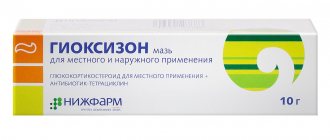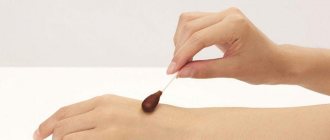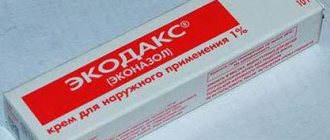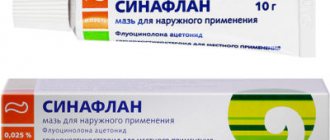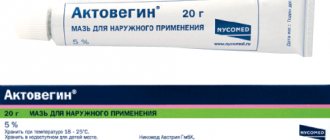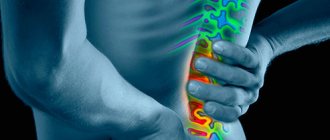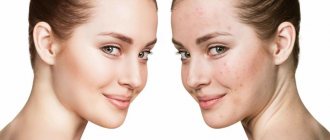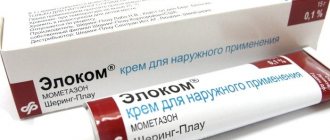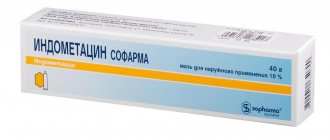Hydrocortisone eye ointment is a hormonal drug (glucocorticoid) that is used to treat a wide range of ophthalmic diseases. It has antiexudative, antiallergic, anti-inflammatory and antipruritic effects. When used, it exhibits virtually no systemic effect (a minimal part of the active substance enters the circulatory system). Hydrocortisone ointment is prescribed for the treatment of conjunctivitis, blepharitis, choroiditis, as well as the relief of allergic manifestations. In order for the drug to be as effective as possible, before using it you need to familiarize yourself with the indications and contraindications, side effects, as well as the technique of applying the ointment to the conjunctival sac.
What does “Hydrocortisone” (ointment) help with?
Composition and action
- 4.1 Hydrocortisone during pregnancy
This glucocorticosteroid is considered a hormonal substance that is used only locally and under professional supervision, accompanied by systemic blood tests, blood pressure measurements, checking for changes in body weight and mental state. The active base that gives the drug its name is hydrocortisone, a derivative of cortisone. It is secreted in crystallized form from the apices of the adrenal glands (available in the adrenal cortex of both mammals and humans). The substance is then synthesized and converted into hydrocortisone acetate. The synthesis helps increase efficiency, reduce the possibility of side effects and enhance the anti-inflammatory effect.
Hydrocortisone acetate
This drug also contains other substances, including:
- stearic acids;
- sorbitol;
- water;
- benzyl alcohol;
- povidone.
The combination of such elements is what makes Hydrocortisone such an effective drug used in medicine in the treatment of various types of pathologies. But due to the fact that it is hormonal, in order to avoid serious complications, self-medication is not recommended.
Hydrocortisone ointment is even used to treat hemorrhoids
Form
The drug in the form of an ointment is manufactured by the pharmaceutical industry in the following containers and dosages:
- external cutaneous form, 1% – 5 or 10 grams, tube;
- external eye ointment, 1% – 2.5 grams, tube;
- the same, but 0.5% - 3, 5 and 10 grams, tube;
- and eye form 2.5% - 2.5 grams each, tube.
Hydrocortisone
Active substance:
Hydrocortisone*
Pharmgroup:
Glucocorticoids
Average price in pharmacies
| Name | Manufacturer | average price |
| Hydrocortisone 0.005/g 3.0 eye ointment | Pharmaceutical plant Elfa A.O. | 128.00 |
| Hydrocortisone 0.5% 3.0 hl ointment | TATHIMPHARMA PREPARATIONS | 33.00 |
| Hydrocortisone 0.5% 5.0 hl ointment/tathimpharm/ | TATHIMPHARMA PREPARATIONS | 41.00 |
| Hydrocortisone 1% 10.0 ointment / biochemist | Biokhimik OJSC | 31.00 |
| Hydrocortisone 1% 10.0 ointment /Nizhpharm/ | Nizhpharm JSC | 30.99 |
Analogs for the active substance:Akortin Hydrocortisone Nycomed Hydrocortisone-POC Hydrocortisone acetate Courtade Cortef Laticort Lokoid Krelo Lokoid lipocrem Solu-Cortef Sopolcourt N | Application area:Allergic reaction to insulin Allergic reaction to insect bites Allergic reaction similar to systemic lupus erythematosus Allergic eczema Allergic eye diseases Allergic diseases Allergic diseases of the mucous membranes Allergic diseases and conditions caused by increased histamine release Allergic skin diseases Allergic skin diseases of non-infectious etiology Allergic skin diseases of non-microbial etiology Allergic diseases of the mucous membranes Allergic skin diseases Allergic conjunctivitis Allergic skin lesions Allergic manifestations Allergic manifestations on the skin Allergic manifestations on mucous membranes Allergic reactions Allergic reactions caused by insect bites Allergic reactions Allergic conditions Allergic dermatitis Allergic dermatitis Allergic dermatosis Allergic diathesis Allergic pruritic dermatosis Allergic conjunctivitis Allergic conjunctivitis caused by chemical and physical factors Allergic swelling of the larynx Allergic rhinoconjunctivitis Allergic eye inflammation Allergic disease Allergic skin disease Allergic skin irritation Allergic condition Allergy Allergy to house dust Graves' disease Bacterial conjunctivitis Blepharitis Pain syndrome during myocardial infarction Werlhof's disease Radiation sickness Variable erythrokeratoderma Hodgkin's disease Spring Qatar Spring keratitis Spring conjunctivitis Pain in cardiac patients Lupus erythematosus disseminated Inflammation of the eyelids Inflammatory soft tissue disease Inflammatory diseases of the eyelids Replenishment of calcium deficiency Replenishment of calcium deficiency Temporary decrease in adrenal function Secondary adrenocortical insufficiency Secondary adrenal insufficiency Secondary adrenal insufficiency Drying of the cornea Non-infectious gastroenteritis Gastroenterocolitis Hemorrhagic diathesis of thrombocytopenic origin Hemorrhagic syndrome of thrombocytopenic origin Hemorrhagic shock Generalized form of Hodgkin's disease Connective tissue hyperplasia Hyperthyroidism Hypoaldosteronism Hypocorticism Purulent allergic dermatopathies Degenerative rheumatic disease Degenerative and rheumatic tendon diseases Degenerative rheumatic diseases Demodectic blepharitis Allergic dermatitis Atopic dermatitis Blistering dermatitis Seborrheic dermatitis Exfoliative dermatitis Allergic dermatosis Dermatosis of neurogenic origin Childhood eczema Radiation diarrhea Exudative diathesis Disseminated lupus erythematosus Adrenal cortex dysfunction Diffuse connective tissue disease Diffuse connective tissue diseases Diffuse neurodermatitis Benign pemphigoid of the mucous membranes Benign pemphigus Gastrointestinal syndrome during irradiation Disease of the cornea with disruption of the integrity of the epithelium Colon disease Soft tissue diseases Malignant lymphoma Malignant exudative erythema Toxic diffuse goiter Itchy atopic eczema |
Indications for use
The drug "Hydrocortisone" is prescribed for the treatment of various skin diseases that are non-infectious or superficial in nature. When used externally, this drug is used to treat diseases such as dermatitis (atopic, seborrheic and contact), eczema and psoriasis.
Indications for use
In addition to dermatological diseases, Hydrocortisone ointment is also successfully used in ophthalmological practice. The prescription of a hormonal drug, as a rule, occurs with the development of the following eye pathologies:
- allergic eye diseases. This includes many different ailments, starting with banal barley and ending with conjunctivitis;
- eyelid skin dermatitis;
- thermal or chemical burns;
- mechanical damage to the organs of vision, accompanied by bruising or swelling.
On a note! Depending on the type of disease, its neglect, as well as the patient’s health condition, the duration of the therapeutic course may vary. But to speed it up, doctors often prescribe the use of ultrasound therapy as part of complex treatment.
Allergic swelling of the eyelids
Who should not use the medicine
Under no circumstances should the drug be used in patients:
- With individual intolerance to the composition of the drug.
- Diseases in which pathological bleeding occurs. These include hemophilia and thrombocytopathy.
- Allergy to the composition of the medicine.
- Inflammation of the joints of an infectious nature such as purulent arthritis.
- Infectious diseases of tendons, periarticular soft tissues, articular ligaments.
- Violation of the body's hemostatic system.
- Destruction of bone tissue when it is replaced by tumor-like formations or other pathological tissue.
- Bone fractures inside the joint.
- History of osteoplastic surgery.
- Pathologies in which some part of the skeleton undergoes necrotic changes. These include systemic scleroderma, Calve's disease, rheumatoid arthritis, and Kibneck's disease.
The mechanism of action of the Hydrocortisone suspension is such that it can be used for children in case of absolute indications and upon reaching three years of age.
Contraindications
Regardless of the composition or therapeutic properties, all medications have certain contraindications. Hydrocortisone ointment also has contraindications, including:
- development of viral diseases;
- diabetes;
- acne vulgaris (acne);
- the course of pregnancy or breastfeeding;
- high skin sensitivity;
- development of skin fungal pathologies;
- inflammation of the skin;
- eye damage.
Hydrocortisone ointment has contraindications
But the main contraindications, of course, include individual intolerance to individual components of the drug. If a patient has been diagnosed with glaucoma, then throughout the entire therapeutic course he needs to regularly check intraocular pressure. Also, the check must be performed when using the ointment for a long time (more than 14 days).
It is strictly not recommended to use hydrocortisone ointment on your own to treat the eyes or increase the course of therapy, as this can lead to serious consequences. Only a doctor can prescribe medication or make adjustments to the treatment course.
The drug has side effects, most of which are associated with skin atrophy. Many people use Hydrocortisone in cosmetology, in particular, to combat wrinkles under the eyes. But experts do not recommend doing this, since the therapeutic effect of the drug will soon wear off, and the number of wrinkles may increase significantly. In addition, improper use of a potent drug can negatively affect the functioning of internal organs and systems. For example, the use of ointment can disrupt the functioning of the adrenal glands, cause swelling or itching, and also cause infectious processes on the skin.
Use Hydrocortisone ointment to eliminate wrinkles around the eyes very carefully. The skin in this area is quite thin and delicate, and under the influence of the active components of the drug, the skin can become even thinner.
Hydrocortisone ointment for wrinkles
special instructions
There are many nuances regarding the use of Hydrocortisone suspension. It is impossible to list them all, and there is no need - the patient will be told everything by his attending physician. But some need to be mentioned. Namely:
- In case of infectious and parasitic diseases of bacterial, fungal or viral origin, caution must be exercised. Especially with herpes simplex or herpes zoster, amebiasis, measles, chickenpox, tuberculosis, mycosis, strongyloidiasis. Treatment of such ailments is possible only with the parallel use of specific medications.
- During the 8 weeks before vaccinations and inoculations, as well as 14 days after, hydrocortisone injections should be administered with caution. The same warning applies to people with immunodeficiency.
- If it is necessary to inject the drug into the joint of a person who is in serious condition, then this must also be done carefully and under medical supervision.
- If hydrocortisone turns out to be ineffective (conclusions can be drawn 48-72 hours after use), you will have to replace it with another medication, also belonging to the group of glucocorticoids. Most likely, the choice will be made in favor of a medicine that does not cause sodium retention. And during therapy you will have to follow a diet with a high potassium content and a low sodium content.
- It is important to know that relative adrenal insufficiency, provoked by hydrocortisone injections, can persist for several months.
- Often, especially in stressful situations, hormonal therapy is combined with the use of salts and mineralocorticoids.
- For tuberculosis, this medication is combined with appropriate drugs that help cope with this disease. If the form of the pathology is latent, then it is necessary to monitor the patient’s condition, and if necessary, carry out chemoprophylaxis.
In addition, before starting treatment, you will need to tell your doctor about your existing diseases and the medications you have to take to eliminate them. Because Hydrocortisone is a serious drug that interacts with many other medications in various ways. And many of them can cause significant harm to the body. Therefore, therapy will be adjusted taking into account all the nuances.
How to use
The drug is gently rubbed into the affected areas of the skin. To achieve optimal effect, the ointment should be applied at least 2 times a day. It is recommended to rub the product in with gentle massage movements - this will improve the absorption of the ointment. The duration of the therapeutic course is 1-2 weeks, but depending on the patient’s health condition, the doctor may extend the course or, conversely, shorten it. If the use of the medicine does not give any effect, then after 5-7 days the treatment is canceled.
When treating eye diseases, the ointment is placed behind the lower eyelid (into the cavity of the conjunctival sac). Your doctor should instruct you on how to properly apply the ointment behind the eyelid. As a rule, “Hydrocortisone” is applied to the eyes 2-3 times a day. Immediately after completing the procedure, you need to close your eyes for a while. This will allow the drug to be evenly distributed over the surface of the eye.
How to put ointment behind the eyelid
Avoid contact of the bottle with the surface of the eyes or the conjunctiva. Otherwise, there is a risk of infection. If you wear contact lenses, you should stop using them for the period of treatment for conjunctivitis or other ophthalmological diseases. With complex therapy, including the use of ointment and eye drops, it is necessary to take a 15-minute pause between instilling the drops and applying the ointment.
The bottle should not come into contact with the eye
It is impossible to abruptly interrupt the treatment course; discontinuation of the ointment must be carried out according to a special scheme according to the doctor’s instructions. Otherwise, sudden cessation of use of the drug may provoke the development of dermatitis and other health problems.
Hydrocortisone during pregnancy
Despite the development of modern medicine, doctors have not yet been able to fully study the effect of Hydrocortisone ointment on the health of a pregnant woman and her unborn child. In any case, it is better to avoid large dosages of the drug and long-term therapy. This is due to the fact that some components of the drug can be absorbed into the bloodstream, which is why there is a possible negative impact on the child’s health.
"Hydrocortisone" during pregnancy
When breastfeeding, doctors do not recommend using Hydrocortisone to treat eyes or skin. Alternatively, breastfeeding will need to be stopped for the duration of treatment. But such changes in the baby’s diet will not benefit him.
Treatment of children
As a rule, Hydrocortisone ointment for eye treatment is prescribed to patients older than 6 months. The skin of a child’s body is not yet fully formed, so potent external drugs can harm their body. In rare cases, doctors still prescribe Hydrocortisone, but only in small doses. The duration of the therapeutic course in this case should not exceed 7 days. Failure to follow doctor's recommendations or exceeding the dosage can negatively affect the child's development.
Features of child treatment
Watch a video about why you need hydrocortisone ointment in your home medicine cabinet:
Application in cosmetology
Medicine is far from the only area of application of hydrocortisone ointment. It is also used for cosmetic purposes. Although there is no information on this in the standard instructions, many people have successfully used the ointment to improve their skin condition. This is due to the hormone cortisol, which is part of the drug. This hormone moisturizes the skin and restores water balance, regardless of its type. Thus, the skin becomes more elastic.
Use of ointment in cosmetology
The drug is also actively used to smooth the skin. To do this, apply the ointment to a face that has been previously cleansed with a special lotion. The product must be applied to dry skin. It is recommended to repeat the procedure twice a day - morning and evening. The duration of the treatment course is 10 days, after which you need to take a 30-day break. Despite the fact that this method gives a short-term effect, it is used by many representatives of the fairer sex.
Watch a video about hydrocortisone blockade of the rhomboid muscle at the Atlant rehabilitation center:
Another way to use Hydrocortisone in cosmetology is to combat acne. This problem is faced not only by adolescents during puberty, but also by adults. In adults, the problem of rash is usually associated with severe stress or hormonal imbalance. The product is applied in a small layer directly to the surface of the eel. It is advisable to carry out this operation before going to bed.
Acne
Reviews
Many people have been prescribed this drug for a variety of conditions. Some patients leave reviews about “Hydrocortisone” in ampoules.
They note that this is a very comprehensive medicine that helps cope with various ailments. And not only for adults, but also for children! And equally effective.
For example, in diseases of the respiratory system, the result appears after the first injection. Unpleasant symptoms smooth out, coughing becomes less frequent, and at night the person finally sleeps normally. By the end of the third day, good health returns.
Hydrocortisone also helps to cope with chronic runny nose (a common problem). Same with regular ones. While other medications cure this problem in a week, Hydrocortisone takes 2-3 days.
Children are very often given inhalations with this drug, which were described earlier. Some parents carry out the procedure immediately as soon as the child shows the first alarming symptoms - and the disease does not have the opportunity to develop.
In general, this is a universal remedy, but it is hormonal - it is impossible to buy it without a prescription, and therefore in any case you will need to undergo examination. And there the doctor will tell you everything in detail about the treatment and its features.
Possible complications
Improper use of hydrocortisone ointment can cause the following side effects:
- disease of the sclera of the eye;
- allergic reaction;
- development of exophthalmos (displacement of the patient’s eyeball);
- high eye pressure;
- a decrease in the immune system, which often leads to the development of secondary infections.
With mechanical damage to the epithelium of the cornea of the eye, there is a possibility of corneal perforation. Long-term use of the ointment can lead to the development of serious ophthalmological diseases such as cataracts or glaucoma. If we talk about drug overdose, this happens extremely rarely. But if this does happen, the patient may experience a slight increase in some side effects (usually local). As soon as treatment with hydrocortisone ointment is stopped, the negative consequences of the overdose disappear on their own.
Overdose
There is no antidote for overdose, but there are no specific symptoms. First of all, local and systemic reactions will intensify. Only manifestations that are threatening in nature are treated. In this case, extrarenal blood filtration therapy is performed.
You can understand that there has been an overdose by the following signs:
- Severe vomiting.
- Water and sodium not removed from the body.
- Elevated glucose levels.
- Hyperglycemic coma and gastric bleeding.
In these cases, the patient is given intravenous ranitidine or cimetidine every six hours.
Analogue drugs
Hydrocortisone is not the only drug in its field. There are other medicines that have similar properties. Let's look at the most common of them.
Table. Review of effective drug analogues.
| Name of the drug, photo | Description |
| "Cortimycin" | An effective medication available in the form of an ointment. It is used in the treatment of various ophthalmological diseases (for example, cyclitis, keratitis, conjunctivitis, etc.). It is often prescribed as a prophylactic agent during the recovery period after surgery. |
| "Laticort" | Another drug produced in the form of an ointment. The active ingredient is hydrocortisone. Used in medicine in the treatment of various dermatological diseases such as eczema, psoriasis, dermatitis. Often prescribed for insect bites. |
| "Pimafukort" | This drug contains micronized hydrocortisone, neomycin and natamycin - these are medicinal substances with anti-inflammatory, antipruritic and restorative properties. Prescribed for the treatment of otomycosis, dermatosis, cutaneous mycosis and other skin diseases. |
| "Solu-Cortef" | Unlike other analogue drugs, this product is available in the form of a white powder. Can be used in medicine in the treatment of ophthalmological, oncological and dermatological diseases. “Solu-Cortef” is also successfully used in the treatment of diseases of the endocrine system. |
| "Lokoid" | Glucocorticosteroid drug intended for external use. It has antipruritic, anti-inflammatory and analgesic properties. As a rule, it is used in the treatment of skin diseases (psoriasis, dermatitis, allergic skin lesions, etc.). |
It is worth noting that most analogue drugs, in addition to hydrocortisone acetate as an active ingredient, also contain other components, usually with antibacterial action. Therefore, before using this or that drug, it is necessary to check the body’s reaction to the action of antibacterial drugs.
The cost of the above drugs, as well as hydrocortisone ointment, is usually low (around 100-300 rubles), which makes them accessible to a wide range of consumers. But in order not to encounter a low-quality fake, before purchasing this or that product, you must carefully examine the original packaging in the photo above.
Pharmacology
The ointment belongs to the group of hormonal agents.
The composition, subject to the rules of use, provides a therapeutic effect with the following effects:
- antiallergic;
- antiexudative;
- immunosuppressive;
- anti-inflammatory.
The active substance prevents the development of proliferative and exudative processes in the focal zone.
After distribution of the drug over the skin, accumulation of its active compounds is observed in the layers of the epidermis (mainly in the granular layer).
Most of the ointment is absorbed into the skin, entering the systemic bloodstream, where it is metabolized with the participation of the liver and kidneys.
Only a small amount of the drug is broken down in the skin layer.
Combination with other drugs
Combination with other hydrocortisone medications is possible, but it must be agreed with your doctor. Especially if you are required to take the longest possible course, tell your doctor what other medications you are using. What you should pay attention to:
- diuretics (potassium-sparing) remove calcium from the body, in addition to hydrocortisone;
- aspirin does not allow the stomach to protect itself from its acidic environment; when hydrocortisone is added to it, ulcers can form on the mucous membrane;
- Patients with asthma using glucocorticosteroid inhalers must inform their doctor immediately.
The drug is potent, so be sure to consult a doctor before using it. During the examination, the doctor will carry out all the necessary diagnostic procedures, after which he will make an accurate diagnosis and prescribe appropriate treatment.
Watch a video about hydrocortisone as an ointment for wrinkles under the eyes:
Pharmacokinetics
There is currently no complete information about the drug. It is known that the hormone can be absorbed into the blood, and it also has a systemic effect. The drug does not completely bind to plasma proteins; from 40 to 90% of the drug enters the plasma.
The medication prolongs placental protection and the BBB. The drug is excreted through the kidneys with urine, breakdown occurs in the liver.
Using anti-wrinkle ointment
Wanting to prolong youth as long as possible, women use all kinds of remedies for wrinkles.
Glucocorticoid-based ointment is available without a prescription, making it available for use for cosmetic purposes (for the skin).
The product is simple to use, and thanks to its pharmacological properties it can eliminate imperfections such as small wrinkles and pimples.
When choosing the drug in question to eliminate wrinkles, it is recommended to take the following precautions:
- treat only the area of the skin where there is a flaw;
- apply the composition, forming a thin ball;
- the duration of the course should not exceed three days;
- Please note that the ointment is a hormonal drug; you may need to consult a doctor.
An excess of hormones provokes serious consequences: osteoporosis, heart disease, diabetes.
The principle of operation of the ointment when used against wrinkles is based on the ability of the active substance to retain moisture in the epidermis, creating a swelling effect. Thanks to this, small folds are aligned. Deeper creases become barely noticeable.
The achieved result lasts a short time, after which the skin returns to its original state. In this regard, the drug should be used only when absolutely necessary with infrequent repetitions.
Important! Ignoring warnings regarding the duration of the course may provoke the opposite effect. It is very difficult to restore atrophied skin.
Side effects
The use of ointment may be accompanied by the following manifestations:
- redness of the skin;
- atrophic changes;
- swelling;
- itching.
With long-term therapy, the risk of developing secondary skin infections and hypertrichosis .
These studies confirm the likelihood of endocrine and immune disorders.
